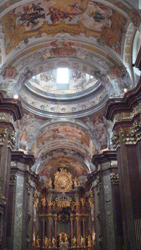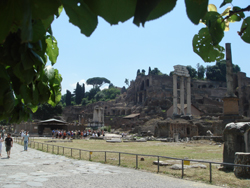 Arriving
in Melk on the train from Viennas Westbahnhof, we caught our
first glimpses of the famed Baroque
Benedictine Monastry. And it most certainly was an impressive
sight. It's difficult to describe the size of the monastry
and how much it imposes over the town in words and, I'm afraid,
my photography didn't do it justice either.
Arriving
in Melk on the train from Viennas Westbahnhof, we caught our
first glimpses of the famed Baroque
Benedictine Monastry. And it most certainly was an impressive
sight. It's difficult to describe the size of the monastry
and how much it imposes over the town in words and, I'm afraid,
my photography didn't do it justice either.
Even more than their Benedictine Brothers in Einsiedeln, the Abbey, visually at least, dominates the town where it is based. Geography saw to that. No-one (at least not I) will accuse the architects of the Kloster at Eisiedeln of lack of ambition in realising their House of God and Abbey at Melk is at least equal in ambition of scale. Perched on top of a a prominent hill, the monastry visually dominates the surrounding village which resides in the valley below it. The sense of drama of the setting is almost palpable and, honestly, it isn't difficult to see where Umberto Eco got his inspiration for for his extensive treatment of the Melk Abbey Library in his book "The Name of the Rose."
 Entrance
to the Abbey is no less dramatic than approaching it. A short,
yet steep walk up steps around the Abbey bring you to the main
entrance. The main entrance, with patron saints Peter and Paul
flanking the gate, opens up beautifully into the first of two
courtyards. Stylistically cohesive, the Abbey is an excellent
demonstration of the "Unifying Spaces" so important
to the Baroque architects of the time.
Entrance
to the Abbey is no less dramatic than approaching it. A short,
yet steep walk up steps around the Abbey bring you to the main
entrance. The main entrance, with patron saints Peter and Paul
flanking the gate, opens up beautifully into the first of two
courtyards. Stylistically cohesive, the Abbey is an excellent
demonstration of the "Unifying Spaces" so important
to the Baroque architects of the time.
Although founded in 1089, the Abbey was rebuilt in the Baroque style by the Abbot of the time Berthold Dietmayr between 1702 and 1736 and this is what we see today. The white and ochre colour scheme compliments the structural form the building.
We picked up the daily guided tour in English (9.50EUR) in the first of the courtyards which took us through the highlights of the monastry. We entered the monastry through a rather impressive staircase and into the Imperial Corridor where we were greeted by an impressive pair of full-length portraits of Maria Therese as Queen of Hungary and Kaiser Franz Stephan von Lothringen as a Commander. Marie Therese visited the Abbey at Melk on three occassions and much of the construction was undertaken during her reign - a high point of this style of architecture.
 We followed the tour through the museum which, in all honesty,
is little more than a marketing effort. I would have much prefered
to have a greater insight into the history of the monastry
and life of Bendictine monks that live there, the school and
the architecture that was offered. But I guess this was more
of a "mass market" offering to someone with a more
specialised interest in the subject at hand. Perhaps I'll do
some independant research for this site?
We followed the tour through the museum which, in all honesty,
is little more than a marketing effort. I would have much prefered
to have a greater insight into the history of the monastry
and life of Bendictine monks that live there, the school and
the architecture that was offered. But I guess this was more
of a "mass market" offering to someone with a more
specialised interest in the subject at hand. Perhaps I'll do
some independant research for this site?
After the museum, we visited The Marble Room - which I challenge
you to be unimpressed by. Bright, airy and skillfully decorated,
the room was originally used for entertaining visiting guests.
And it's not difficult to see why. (If my living room looked
like this - well - I wouldn't be running this site!) The cieling
is marvellously decorated and, although it appears to be a
curved cieling it is actually painted to give the appearance
of being curved towards the top. Structually, it's flat and
the paiting, through a cunning use of perspective, give the
illusion of being a curved construction.  (Tip: stand
slap bang in the middle of room on the grill and look directly
up then stand either or both ends and look along the cieling.
At only one place do the columns of the cieling appear vertical!)
(Tip: stand
slap bang in the middle of room on the grill and look directly
up then stand either or both ends and look along the cieling.
At only one place do the columns of the cieling appear vertical!)
The Library, which is a second most important building in any Benedictine Monastry, was followed the Marble Room on our tour. Comprising over ten floors (we were on one, eight floors below us and two above us) the library was mightly impressive. Several thousand books, including secular scientific texts as well as religous texts, packed the shelves. The oldest book, dating from around 840, is on display in the cabinet.
As one of the most important buildings in the monastry,
the
Library is an impressive size.
 There are a couple of floors
above the one you visit and several below and the library,
as a result, contains several thousand books. The fame of the
Abbey, as well as it being a centre of academic and scholastic
learning, was a large contribution to keeping the Abbey from
dissolution under Emporer Joseph II as a result of the Napoleonic
Wars.
There are a couple of floors
above the one you visit and several below and the library,
as a result, contains several thousand books. The fame of the
Abbey, as well as it being a centre of academic and scholastic
learning, was a large contribution to keeping the Abbey from
dissolution under Emporer Joseph II as a result of the Napoleonic
Wars.
From the main library floor, which is accessible to the tour, there is a spiral stair case from which all library floors are accessible. I'm generally eneamoured of spiral staircases and this one is special. The underside has been decorated and the whole underside is a peculiar form of pink which makes the whole thing look like a gigantic shellfish which has been stretched out into a great-big spiral staircase. Quite amazing.
 The highlight of a visit to the Abbey is the Church which is
nothing if not oppulently decorated. The high altar is thought
to be the design of Giueseppe Galli-Bibiena and the statues
were executed by Peter Widerin after models produced by Lorenzo
Mattielli. The altar depicts Peter and Paul bidding each other
farewall - the prophets of Daniel, Jeremiah and David are depicted
to the left and Isaiah, Ezekial and Gideon are depicted to
the right.
The highlight of a visit to the Abbey is the Church which is
nothing if not oppulently decorated. The high altar is thought
to be the design of Giueseppe Galli-Bibiena and the statues
were executed by Peter Widerin after models produced by Lorenzo
Mattielli. The altar depicts Peter and Paul bidding each other
farewall - the prophets of Daniel, Jeremiah and David are depicted
to the left and Isaiah, Ezekial and Gideon are depicted to
the right.
Melk Monastry also functions as a school for around 900 boys and girls from the parishes surrounding the Abbey.







